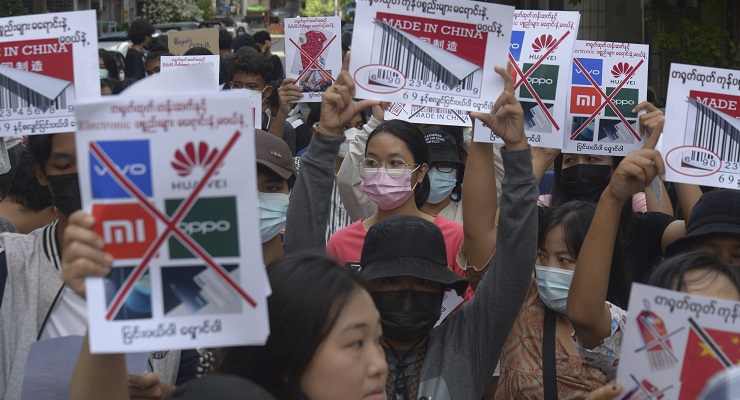
Ten weeks since the coup, violence by Myanmar’s military has claimed at least 700 lives, seen more than 3000 people detained and triggered a swelling flood of refugees from the country.
At the same time, it has laid bare China’s dilemma about its southern neighbour as reports mount of Chinese troops gathering on Myanmar’s northern border, keen to try and protect the Middle Kingdom’s vast economic interests. China’s Foreign Minister Wang Yi warned other South-East Asian nations this week to be alert to “external forces” infiltrating Myanmar.
China is Myanmar’s largest trade and military partner. It was as surprised by the February military coup as the rest of the world. Only two weeks earlier, Wang was in Myanmar for talks with the now detained former state counsellor and de-facto government leader Aung San Suu Kyi, as well as military leaders.
But the return of the military — in all its ugly contempt for its own citizens — is so far playing out as a nasty speed bump in China-Myanmar relations rather than the deal breaker it is for the West.
China has resisted any efforts of the United Nations Security Council for action and, at least in public, been sanguine about the power grab. China’s state-run media described the coup as a “cabinet reshuffle”.
Client state fears
The two countries have a long, deep and very complex relationship. One of the key reasons behind the junta’s decision to begin opening up to the outside world, along with political reform in the late 2000s, was fear of becoming a Chinese client state, a fate that has befallen Cambodia and Laos in the past decade.
Yet Beijing has remained as a close and largely uncritical partner, giving its full imprimatur to the Rohingya ethnic cleansing/genocide. The similarities in intent and timing of this program, which began in mid-2017, to the Chinese Communist Party’s horrific persecution of the Uighurs in Xinjiang (who, like the Rohingya, are a Muslim ethnic group) are stark.
But the return of the full and violent force of military rule creates problems for Beijing. It ends attempts to bring peace to the country’s many warring groups and the central government, a pet project of Aung San Suu Kyi since she gained power in 2015. Already there are signs of escalating conflict between the military and the multiple ethnic militias that pepper the seven ethnic states along Myanmar’s borders.
Wars are not good for trade in resource-rich areas. Nor are they good for the building and operating of energy pipelines and a super-highway, which are the centrepieces of the planned China-Myanmar Economic Corridor (CMEC).
This is a top priority project for Xi Jinping’s Belt and Road Initiative that will give China direct access to the Bay of Bengal and its significant energy reserves, and a game-changing shortcut to Middle East trade, cutting out the Straits of Malacca and the South China Sea.
Indeed, this project is so central to China’s economic and influence expansion plans that Xi visited the capital Nay Pyi Taw to revive what has been a troubled project, inking 33 new memoranda of understanding.
Problematic location
The CMEC has the misfortunate of running through northern Shan, Kachin, Chin and Rakhine states — regions of Myanmar that were most roiled by the civil wars that have ravaged the country before the coup, with the Myanmar military battling five different (but aligned) ethnic militias.
As is the case in most South-East Asian nations, anti-China feeling among regular citizens is high. They understand that China would like to add Myanmar to Cambodia and Laos as effective client states. The Myanmar military’s problem is that on the ground, anti-Chinese feeling exploded last month, with mobs burning Chinese factories in Yangon’s industrial heartland triggering marshal law in six city districts.
The prize of Myanmar, once known as Burma and one of the jewels in the crown of British imperial India, remains glittering. Like many of its neighbours, there is a significant Chinese diaspora in Myanmar, although historically it was never as significant or deeply entrenched as in Thailand, Malaysia or Indonesia, for instance.
But Chinese migration has increased dramatically in recent years, particularly in the north of the country, where the Chinese have been investing in mining and agriculture. China has also had long-standing interests in the illicit drug trade, once dominated by heroin production but more recently by laboratories for the cheaper-to-produce and easier-to-market methamphetamine. Its second largest city and commercial centre Mandalay has, like Chiang Mai and Khon Kaen in northern Thailand, become a “Chinese” city.
As messy as it is, and deleterious to investment in the short- and medium-term, China may also see advantage in the return to authoritarianism in Nay Pyi Taw, as other investors in the resource-rich country are fleeing and staying away.
China’s role in the conflicts — both new and existing — are in sharp focus. It clearly has a central role to play in trying to find a solution to the current situation inside Myanmar. Another failed state like North Korea on its border would be a disaster for Beijing.
But also being tested is China’s capacity to be a force for stability and cohesion in the region. What happens next in Myanmar may well have repercussions for China and the region for many years to come.








Among other factors, it is the Chinese border with Myanmar that acts as a strong deterrent for the West to embark on any unilateral initiatives (eg Iraq, albeit for different motives) to assist the Burmese people in a physical sense. Neither China nor the West wants a repeat of Korea, and the Chinese feeling threatened by the West on its borders.
I cannot see where the “acid test” is for China. The Myanmar military coup leaders are only doing in public the sorts of things the CCP does in the far reaches of its own country. China is not embarrassed about its own actions domestically, why would it be perturbed about what the Myanmar military doing on its turf. After all. the Myanmar military are probably using weapons gifted or sold by China – a win win outcome for China.
Just another anti Chinese article. Why not blame it all on China.
What elements do you consider incorrect in the article?
Where is the evidence for this. The similarities in intent and timing of this program, which began in mid-2017, to the Chinese Communist Party’s horrific persecution of the Uighurs in Xinjiang (who, like the Rohingya, are a Muslim ethnic group) are stark. Its the same as blaming Russia for protecting Russian speakers in Ukraine, every one who is informed knows those Ukrops will from the west will murder thousands of them given half a chance.
wow. I mean, those Russian speakers in Easter Ukraine ( now protected by Russian sympathetic elita) were part of Ukraine for some years, without getting murdered in the thousands, but, who was to know. I guess the Western Urkrainians must have had a secret plot that you have seen right into.
Did you miss where those Russian speakers were killed a couple of years ago when the conflict was hot. Are you going to claim no Russians living in Crimea would have been harmed if the Ukrops got in and took control. Are you a Catholic sympathiser?
Ethnopolitical Conflicts in Eastern Ukraine and the Increasing Tension in Donbass | ANKASAM | Ankara Center for Crisis and Policy Research